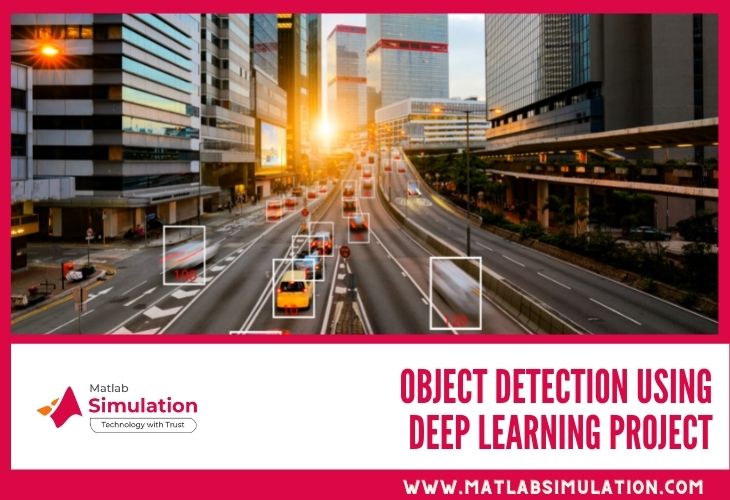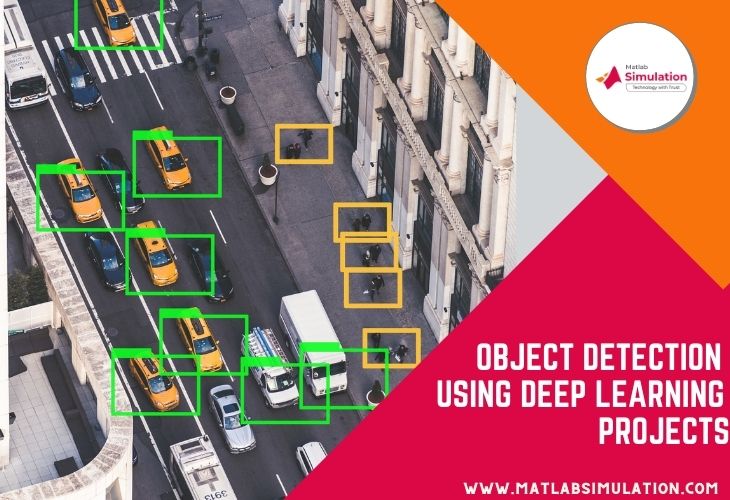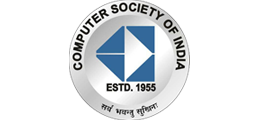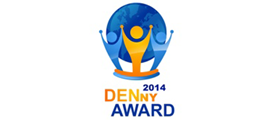The word “Deep” in deep learning (DL) signifies the number of layers/stages that are used to find and process the specific object. All these layers/stages undergo several training processes. Deep learning enables to perform different computations on processing layers for better learning and interpretation of data. All these multi-layers processing are implemented on different abstraction levels.
This page provides you with all-inclusive research information for the Object Detection Using Deep Learning Project!!!
In the field of computer vision, “object detection” is considered to be one of the puzzling tasks in computer vision. Therefore, it attracts major research scholars’ attention in a short period itself. In that case, deep learning influences scholars to choose object detection area as their research field. Since it improvised the detection techniques through its deep knowledge gaining capability.
What is object detection in deep learning?
In computer vision, object detection is the major operation to be carried out to trace the particular object in an image. The object can be detected based on some conditions like features, background state, etc. For efficient object detection, a deep learning technique can be used. Since, it recognizes the patterns like color, texture, edges, etc. accurately through multi-layers processing.
Technically, the object detection task is performed by employing a bounding box over the particular object and classification based on certain patterns in each bounding box. In comparison with other common techniques, deep learning is an advanced technique for one or more objects.
Deep-learning techniques are also popularly known for their representation capability. So, it is also are referred to as representation-learning which represents the data in multiple levels. It is achieved by several non-linear modules which convert representation from one level to other higher-level just like abstraction levels. One special aspect of deep learning is that these multi-level feature layers are not created by a human instead they are created by independent learning of data.
Why is Object Detection important?
As mentioned earlier, object detection is one of the major issues in computer vision. Since, it acts as a baseline for other processes of computer vision like image captioning, objects tracking, segmenting, etc. You can identify this object detection using deep learning project process in many real-time applications such as text detection, people counting, number-plate detection, walking person detection, pose detection, face detection, etc.
How does object detection work?
Now, we can see how the object is detected in images. The first thing that needs to be focused on object detection is the count of foreground objects in images. To interpret the object detection process, just assume that handpicked image has only one object.
When the image has one object then the processes like placing bounding box, finding object coordinates, classifying object, etc. will be executed indirectly way. For instance, one can use the main parameters that are used to attain the class of objects in an image.
Further, these parameters facilitate to construction graph where every parameter is independent of to graph level. Let’s see some of the important parameters of object detection using deep learning project.
Object Detection Simulation Parameters
- Texture
- Area
- Eccentricity
- Orientation
- Posture Angle
- Euler Number
- Color Intensity
As mentioned earlier, the object can be figured out by drawing the bounding box based on certain parameters/conditions. Generally, the bounding box comprises four numbers accordingly bounding box location that can be learned through regression method. Next, the object is classified into an appropriate category based on similar patterns.
o solve the above-specified regression and classification issues, a convolutional neural network (CNN) is proposed. Similar to conventional processes (key-points recognition, semantic segmentation, and image identification); this object detection also has a limited number of targets. Overall, these problems can be solved by limited regression and classification problems. Here, we have given the steps of “object detection using deep learning project” for your reference.
Deep Learning-based Object Detection
- At first, load the images
- Then, perform convolution and pooling processes of multi-layers
- Next, implement feature mapping
- At last, it classifies the object class with box coordinates (x, y, width, and height)
Our research team has come up with a crossed several Object Detection Using Deep Learning Projects. So, we can identify the suitable advanced techniques and algorithms depending on your research objectives. To compute the degree of suitability, we undergo deep research on recent techniques used for related topics and perform a comparative study.
In this way, we analyze the merits and demerits of all current research solutions. Then, our experts propose the best algorithms or design new algorithms to fulfill the research gaps of those techniques. Here, we have given you the top 10 algorithms for object detection.
Top 10 Algorithms for Object Detection
- Single Shot Detector (SSD)
- Convolutional Neural Network (CNN)
- Mask RCNN
- Spatial Pyramid Pooling (SPP)
- Fast R-CNN
- Region-based CNN (R-CNN)
- Faster R-CNN
- Histogram of Oriented Gradients (HOG)
- Region-based Fully Convolutional Network (R-FCN)
- YOLO (You Only Look Once)
In addition, we have also given you other important object detection algorithms for current scholars / final year students’ benefits. In this, we have mentioned the key specifications of algorithms. If you need keen assistance in handpicking suitable research solutions for your handpicked research problems, then make connections with us. Our experts will suggest you best-fitting techniques based on your needs.
Latest Object Detection Algorithms using Deep Learning
- MobileNet
- Single-shot multiple-box detection network
- Utilize Caffe framework for object detection
- Output vector include tracked object data
- YOLOR
- Train model based on explicit and implicit knowledge
- Grasp knowledge on representation to perform multi-tasking
- Bind implicit knowledge with explicit knowledge via multi-tasking, kernel space alignment, and forecast refinement
- In overall, it gives improved performance and accuracy
- SqueezeDet
- Type of deep neural network
- Intended for computer vision applications like driver-less driving
- Similar to YOLO, the single-shot detection method
- Use convolutional layers to filter the feature maps and output layer to determine object class and bounding boxes
- Rapid process due to neural networks-single forward
Deep Learning for Moving Object Detection
For illustration purposes, here we have taken “Moving object detection” as an example task. Since it is significant is recognized in many real-time applications of image processing and computer vision fields. For instance: safety surveillance, road traffic monitoring, pedestrian detection, etc.
On knowing the importance of this task, several advanced techniques are developed and still developing. Although these techniques give maximum effort in providing the best results, some technical issues limit the efficiency of accurate detection. And, some of those issues are given as follows,
- Occlusion
- Uncontrollable Contextual Objects
- Illumination Concerns
Next, we can see recent research issues of moving object detection. Here, we have given general factors that affect the performance of moving object detection systems. Our developers are smart enough to overcome these issues by taking effective countermeasures. As mentioned earlier, we are keen and precise in identifying the best solutions. In the case of complications, we design our algorithm or create hybrid techniques to solve those problems. On the whole, we are best to create solutions for any kind of critical challenges. We support you not only in moving object detection using deep learning but also in others.
Critical challenges in moving object detection
- Photo Camera Problems
- Rapid Unplanned Movement of Object
- Random Moving Shadows
- Multifaceted Image Backgrounds
- Appearance Variation in Mobile Objects
- Image Color Illumination Issues
- Occlusion over Object in Image
Workflow for moving object detection using deep learning
Generally, the whole video is split into multiple frames in sequential order. To detect the object in the frame, there are different image processing approaches are available. Then, it finds pixels relations in multiple frames to trace the object movement. For better understanding, here we have given you the 4 main steps for analyzing moving objects in video.
- Feature Point Learning & Classification
- Moving Object
- Detection
- Tracking
- Analysis
Now, we can see the different datasets for object detection using deep learning project. For any kind of real-time / non-real-time application, the dataset has a key player role. Since the outcome of the developed system is majorly dependent on the dataset. When we discuss object detection, the dataset may include images/videos/images and videos.
Depending on the project requirement, the dataset should be accurately detected. From our experience, here we have listed some extensively used datasets in object detection. And, if you are interested, then we also suggest you apt dataset for your project.
Datasets for Object Detection
- LISA Traffic Sign Detection Dataset
- Laboratory for Intelligent & Safe Automobiles
- Large-scale Traffic Sign Dataset
- With Images
- With Video and Images
- 47 – US sign types
- 6610 boundaries
- 7855 annotations
- CIFAR-10
- Large-scale dataset
- 10 – Diverse categories
- 60,000 – Colour images
- 10,000 – Test images
- 50,000 – Training images (5 Groups)
- Include US traffic signs with Video and Annotated frames
- ImageNet
- Large-scale dataset classified based on WordNet hierarchy
- Every system connection is described by more numbers of pictures
- Purpose
- ML algorithms generalization
- Overcome computer vision difficulties
- MS Coco
- Huge-scale object detection dataset
- 1.5 million – object instances
- 80 – object classes, etc.
- Focus on following areas of scene detection
- Non-iconic scenes of objects detection
- Precise 2D object localization
- Background reasoning within objects
- Include features of superpixel stuff segmentation, object segmentation, and circumstances recognition
For illustration purposes, here we have the fundamental steps to implement a general moving object detection using deep learning project. Once you confirm your project topic with us, then we give you the implementation plan of your project. This file holds information on development procedures, software requirements, and performance assessment metrics. And also, we revise the plan based on your suggestion. After final confirmation, we develop and deliver your project within your stipulated time in top-quality results.
Steps in Moving Object Detection
- Step 1 – Load video sequence as input
- Step 2 – Find foreground and background feature points
- Step 3 – Update scheme and perform perspective transform
- Step 4 – Collect updated foreground feature points and regions based on the difference of image
- Step 5 – Implement integration scheme and detect moving object regions
- Step 6 – Compensate and improve the object region
- Step 7 – Find the moving object
- Step 8 – Investigate the moving object
- Step 9 – Visualize the output
What are the metrics used for object detection?
Although there are numerous object detection methods were introduced, the accuracy of object detection is lacking. So, here we have given you a few key metrics that are used to measure the accuracy of object detection. And they are given as follows,
- Average Precision
- Mean Average Precision
- Loss Function
- Frames / Second
Same as accuracy metrics, other major metrics are used for assessing object detection methods as YOLO, Faster R_CNN, and Mask R-CNN. These metrics can also be used to assess PASCAL VOC and COCO issues.
Summary,
To sum up, object detection is a tricky task to perform, since it differs from image to image. For identifying the object in an image, the anchor was introduced to select the particular window. Here, the anchors can be directly drawn from data or designed based on the position and size of the windows.
Initially, the anchor concept is suited for one-stage object detection algorithms. Then, it is incorporated with bounding box concept two-stage methods. In one-stage methods, the objects are directly detected. In two-stage algorithms, anchors suggest region at first and then decide object classes and close-fitting bounding boxes.
- For instance:
- One-stage method – YOLO (low accuracy)
- Two-stage method – SAS Deep Learning (high accuracy)
Last not but not least, we assure you that we give complete development service on object detection using deep learning project with research support. We will be with you from the beginning of the topic selection to till the end of the project manuscript/thesis submission. In other words, we will take whole responsibilities of your project and direct you on the right path to reach your goal line. To the great extent, we also support you in other deep learning-related areas such as machine learning, computer vision, natural language processing, semantic analytics, web and ontology analytics, etc.














